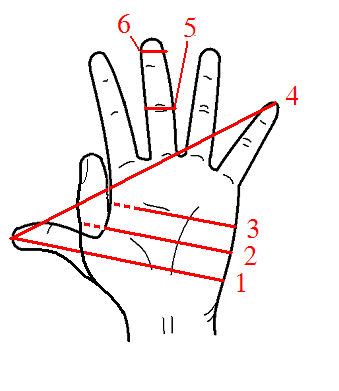Finger (unit) on:
[Wikipedia]
[Google]
[Amazon]

 A finger (sometimes fingerbreadth or finger's breadth) is any of several units of measurement that are approximately the width of an adult human finger. xactly which part of the finger should be used is not defined; the width at the base of fingernail (#6 in the sketch) is typically less than that at the knuckle (#5).
The digit, also known as digitus or digitus transversus (Latin), dactyl (Greek) or dactylus, or finger's breadth of an inch or of a foot. (about 2 cm)
In
A finger (sometimes fingerbreadth or finger's breadth) is any of several units of measurement that are approximately the width of an adult human finger. xactly which part of the finger should be used is not defined; the width at the base of fingernail (#6 in the sketch) is typically less than that at the knuckle (#5).
The digit, also known as digitus or digitus transversus (Latin), dactyl (Greek) or dactylus, or finger's breadth of an inch or of a foot. (about 2 cm)
In
medicine
Medicine is the science and Praxis (process), practice of caring for patients, managing the Medical diagnosis, diagnosis, prognosis, Preventive medicine, prevention, therapy, treatment, Palliative care, palliation of their injury or disease, ...
and related disciplines (anatomy, radiology, etc.) the fingerbreadth (literally the width of a finger) is an informal but widely used unit of measure.
In the measurement of distilled spirits, a finger of whiskey refers to the amount of whiskey that would fill a glass to the level of one finger wrapped around the glass at the bottom.
Another definition (from Noah Webster): "nearly an inch."
Finger is also the name of a longer unit of length, used historically in cloth measurement, to mean one eighth of a yard or 4 inches. (114.3 mm) Again, which finger and whose finger, is not defined.
These units have no legal status but remain in use for 'rough and ready' comparisons.
See also
* ('6' in the diagram above) * * (before 1826) * (from 1826) *References
Units of length Human-based units of measurement {{Standard-stub